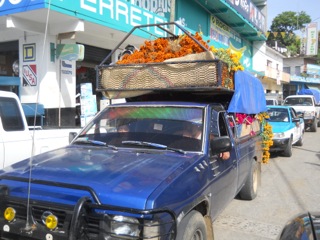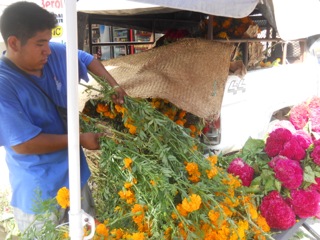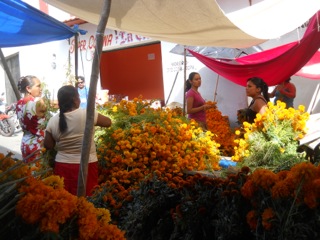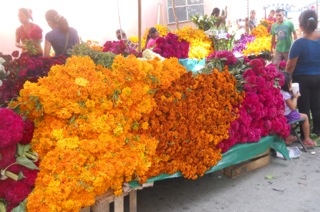
I arrived at the airport in the middle of the night and was driven by taxi along a dark winding two lane hi-way. Forty-five minutes later I walked into my hotel room on a hilltop overlooking the Pacific. I woke up just after sunrise and stepped out onto the balcony and into my new life.
It was not the sweet, heart-shaped bay of Puerto Angel that first captured my attention, or the clear turquoise water, dotted with fishing boats. No, it was the Pantheon, the cemetery, with its blue and white tombstones, humble and grand, scattered haphazardly over a tree shaded hillside facing the sea. “Yes”, I heard my own voice say “ this is the place for my bones.” That was more than 20 years ago. Today, I am seventy-one and my home is Puerto Angel, Oaxaca.
A carpet of orange petals becomes a path from the street to the house . . .
Death is the main event in Mexico and that’s where my love affair began. So it makes sense that the Day of The Dead — which is really a week-long, cultural and spiritual experience which brings together diverse customs, myths and rituals across the entire country — has special significance for me.
On Monday the 28th of October the crowded open-air market in Pochutla, the largest town near Puerto Angel, explodes with flowers. Mountains of the traditional yellow orange cempasúchitl (large marigolds) and the tall crimson Santa Theresa are piled high along the main street. I have them growing in my garden.

But the biggest flower day of the week is Thursday October 31st. That's the day most families build altars in their homes. Then, in the dark of that same night, the first spirits arrive. All the babies and children who have died come home to eat the special bread and fruit and nuts that their family has prepared and then left for them in front of the altar. To help the spirit-children find their way home, a carpet of bright orange cempasúchitl petals becomes a path from the street to the house.
But these family altars also pay homage and invite the spirits of all family members to come back. Photographs large and small — of fathers, mothers, brothers, cousins, friends — feature prominently. along with artifaces from the lives of the departed: a machete, a hat, a pack of smokes, a cane, an apron, a cerveza. Sometimes music is played. Everything is done with tender love to welcome the spirits (some say ‘souls’) back home.
All week long women go in the mornings to clean the cemetery: to take away garbage and dead flowers and weeds; sometimes to re paint a tombstone or replant flowers or straighten a crucifix. The cemetery is full of people doing what needs to be done. Joking and tongue-wagging about this family or that one who have not shown up to do their part. In the end someone always does it, a family member or neighbor or a total stranger.

On the morning of the 1st of November, women in the family gather in the kitchens to prepare different kinds of tamales, both savory and sweet. Vats of rich creamy hot chocolate stand beside baskets of Pan de Muertos, a special slightly sweet bread with little angel figures. Traditionally it was baked in the home but now there are bakers who make it in round wood burning barro ovens to sell in the market or house to house. We still have some of the old outdoor ovens in town, but sadly fewer each year.
The animals stood around us, silently watching in the moonlight.
I remember the evening long ago when my friend Wilfredo invited me to come with him to his friend’s house to help bake the bread in one of those ovens. I followed his three grandkids along the crooked stony path to Sr. Shiflito’s house. The oven was outside in the compound with all his dogs, cats, chickens, a few goats and a burro. I was taught by Beto, one of the children, how to place the tiny angel face into the small carefully formed ‘pan de muerto’ before it was baked in the oven. I quickly learned it’s not as easy as it looks and the kids tried not to giggle when often they had to correct my ‘crooked angel heads’. We worked into the night. The moon rose. When we were finished, we ate the bread, warm and fresh from the oven while the animals stood around us, silently watching in the moonlight — all but the chickens who perched in a line along a fence, each head tucked under a wing, fast asleep. We walked back home, along the path, bellies full of bread hoping to see a spirit, “a friendly spirit”, the kids promised with a nervous smile.

On the evening of Nov 1st, families visit one another bringing food for the altars. It’s a festive time in the town with a unique energy like no other; a subdued blend of nostalgia, happiness and a kind of open hearted ‘celebration’ of death as an integral part of life, a drawing together to take care of those left behind. The desire to show the departed that they are loved and cherished forever contains a common hope that the same will be true for our own spirits when the time comes. There is tangible comfort in sharing the feeling that we are all connecting to something, that in the end we know we experience alone.
People return to their hometowns for these days. Porches and patios are full to overflowing with friends and family, eating, drinking and remembering. Stories of the departed are told and retold each year. Lots of laughter and inevitably some tears, irreverence and squabbles. Family holiday dynamics are pretty universal. The children are allowed to stay up late, and, fueled by hot chocolate and pan de muerto they run like little wind-up toys until they drop, suddenly asleep in someone’s embrace.
See Part 2 of this two-part series.
M. S. MARTIN is a retired Canadian film editor, director, producer and writer who worked in the US and Canada, She lives with her two Xoloesquincles, Pancho and Xonena in Puerto Angel Oaxaca Mexico and is writing her first novel.
Photos by the author.


Comments
Thank you, Susan, for such a
Thank you, Susan, for such a beautiful portrait of Puerto Angel during the most important festival of the year You bring the people and the spirits to life - you can be sure they will honor you well when its your turn! Your writing reminds me of one of my favorite writers on Mexican life - Harriet Doerr who wrote "Stone for Ibarra" and "Consider This, Señora" - luminous and full of gems. I'm looking forward to reading your novel. Keep writing. Que te vaya bien!
Add new comment